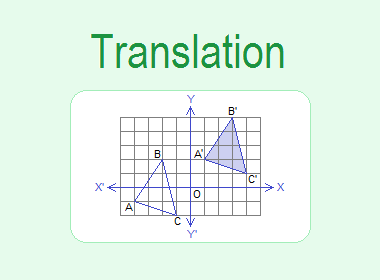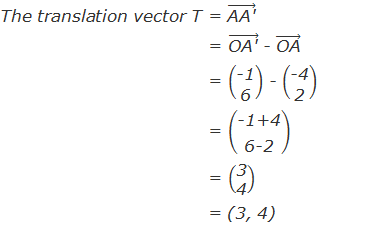
The Translation is a transformation in which
each point of the given object is displaced through definite distance and
direction. The displacement is defined by a translation vector (a, b).
********************
10 Math Problems officially announces the release of Quick Math Solver and 10 Math Problems, Apps on Google Play Store for students around the world.
********************
********************

The following are the properties of translation:
1.
The object and the image
under the translation are congruent.
2.
The lines joining any point
of the object with its corresponding image are parallel and equal.
Example 1: Find the image of ΔABC under the translation through translation
vector PQ.

Solution:
To get the image of ΔABC under the translation vector PQ draw
the lines through A, B, and C which are parallel and equal to PQ in the same
direction to get the images of A, B, and C and join them to get ΔA’B’C’.

Translation Using Co-ordinates
The image of the geometrical figures under the translation through certain translation vector can be obtained with the help of co-ordinates.
Translation Through Translation Vector T = (a, b)
Let A(2, 1) be a point and T = (2, 3) be the translation
vector. To translate A(2, 1) through translation vector T = (2, 3), it has to
move 2 units right and then 3 units up which is the point (4, 4)

Hence, A’(4, 4) is the image of the point A(2, 1) under the translation vector T = AA’ = (2, 3).

Let us see the following table of some other points on the same graph and their corresponding images under the translation through translation vector T = (2, 3).

From the above table, we can see that the image of any
point under the translation through translation vector (a, b) is obtained by
adding a to x-coordinate and b to y-coordinate of the given point.

Worked Out Examples
Example 2: If A(-4, -4), B(-2, -1) and C(-1, -5) are the vertices of a
triangle ABC. Find the co-ordinates of the image of ΔABC under the translation
T =(6, 5). Draw ΔABC and its image on the same graph paper.
Solution:
As A(-4, -4), B(-2, -1) and C(-1, -5) are the vertices of ΔABC, the co-ordinates of the vertices of image of ΔABC can be obtained by using the formula as below:

Drawing ΔABC and ΔA’B’C’ on the same graph paper we have figure
as shown.

Example 3: A(-4, 2), B(0, 1) and C(-2, -3) are the vertices of ΔABC. If A’(-1,
6) be the image under the translation of vertex A. Find the images B’ and
C’ of B and C under the same translation.
Solution:
Here, as the image of A(-4, 2) under the translation is A’(-1,
6),

Now, under the same translation, the image of B(0, 1) is B’(0+3,
1+4) i.e. B’(3, 5) and the image of C(-2, -3) is C’(-2+3, -3+4) i.e. C’(1, 1).
Example 4: Translate a point A(2, 7) under translation T1 = (4, -3)
to the point A’. Translate A’ to A’’ under another translation T2 =(2,
4). Find the translation vector which translates A to A’’.
Solution:

Now, let T be the translation vector which translates A(2, 7) to
A’’(8, 8).

Example 5: Translate the point M(4, -5) by the translation vector T = (-3, 4)
and find the image point M’ and write down the translation vector which maps M’
to M.
Solution:

Let T’ = (a, b) be the translation vector which maps M’(1, -1)
back to M(4, -5). Then,

Therefore,
1+a = 4
or, a = 4 – 1
or, a = 3
And,
-1+b = -5
or, b = -5 + 1
or, b = -4
∴ The required translation vector is (3, -4) which is called the inverse of T and written as T-1.
i.e. If T = (a, b) then
T-1 = (-a, -b).



Am vary happy for your lesson
ReplyDeleteGreat and straight forward lesson. Making Translation much easier
ReplyDeleteThank you.
A point p is translated by vector (3,4)to point p(6,5).find the coordinates of p
ReplyDeleteCoordinates of P = (6-3, 5-4) = (3, 1)
Delete